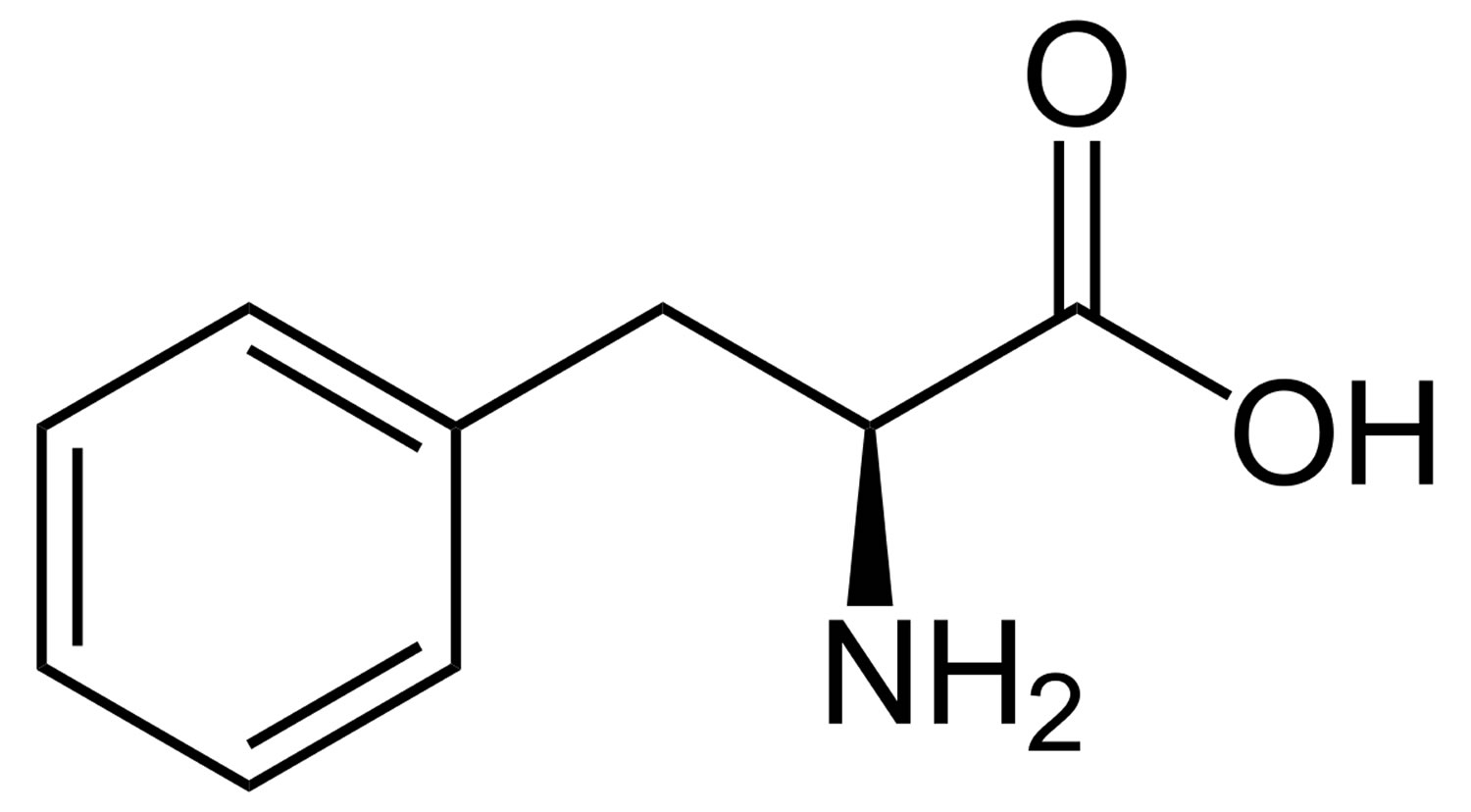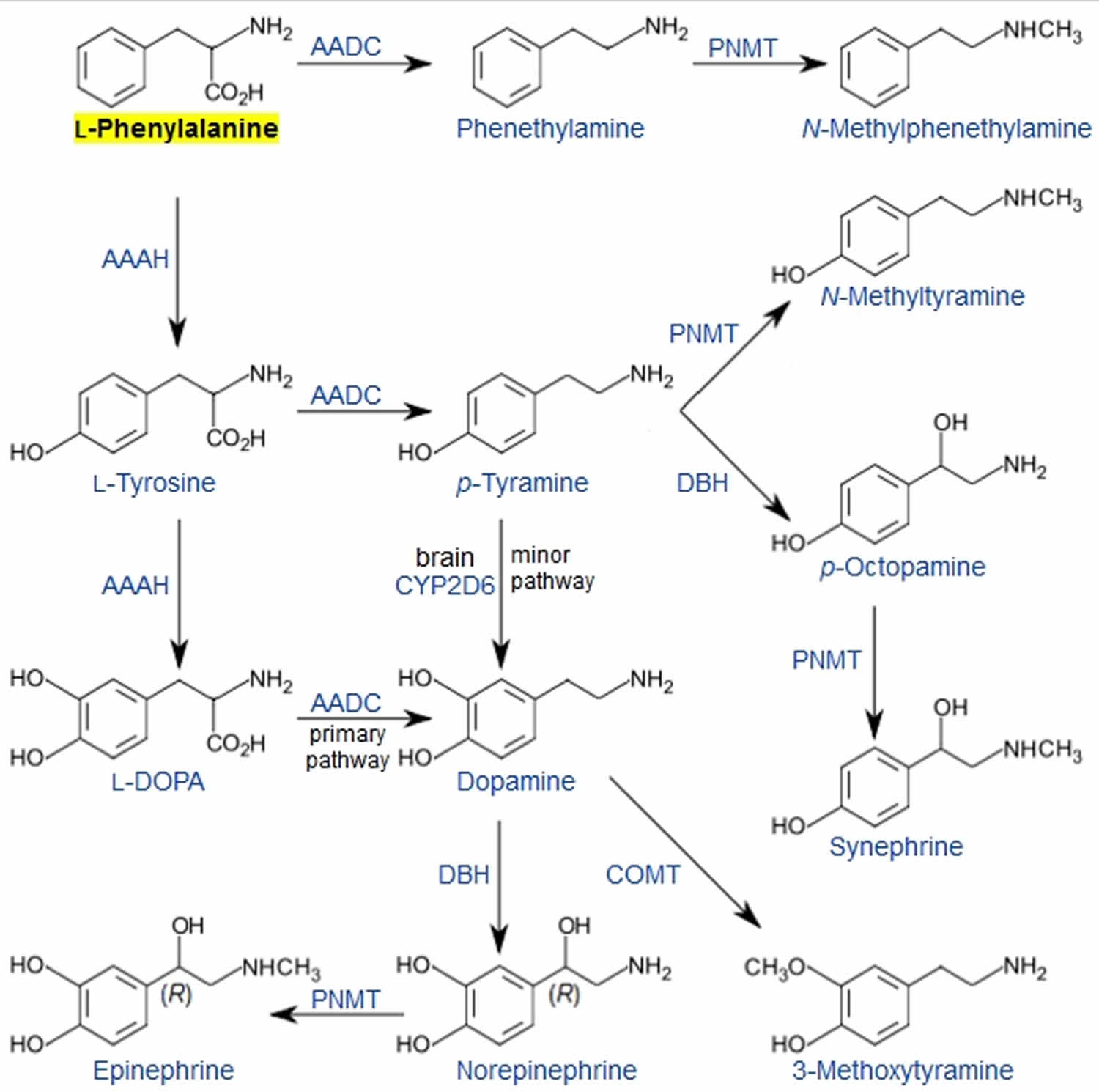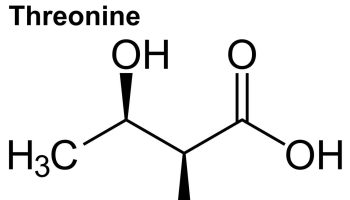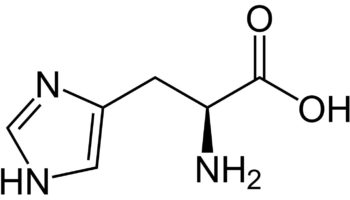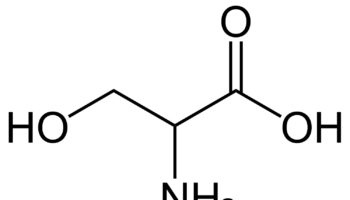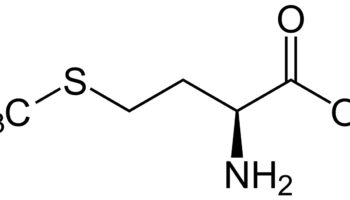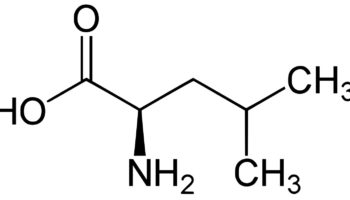Contents
What is phenylalanine
Phenylalanine (C9H11NO2) is an essential amino acid in humans that comes from a person’s diet and is used by your body to make other amino acids and is important in the structure and function of many proteins and enzymes. The L-isomer (L-phenylalanine) is used to biochemically form proteins, coded for by DNA, while the D-form (D-phenylalanine) acts as a painkiller. Phenylalanine is converted to tyrosine, used in the biosynthesis of dopamine, norepinephrine (noradrenaline) neurotransmitters and the skin pigment melanin. Melanin pigment is responsible for skin and hair color. Like tyrosine, phenylalanine is also a precursor for catecholamines including tyramine, dopamine, epinephrine (adrenaline) and norepinephrine (noradrenaline). Catecholamines are neurotransmitters that act as adrenaline-like substances. Interestingly, several psychotropic drugs (mescaline, morphine, codeine, and papaverine) also have phenylalanine as a constituent. Phenylalanine is highly concentrated in the human brain and plasma. Normal metabolism of phenylalanine requires biopterin, iron, niacin, vitamin B6, copper, and vitamin C.
As an essential amino acid, phenylalanine is not synthesized in humans, you must eat phenylalanine or phenylalanine-containing proteins. For infants, the source of phenylalanine can be either breast milk 1 or infant formula (containing DHA/arachidonic acid). An average adult ingests 5 g of phenylalanine per day and may optimally need up to 8 g daily. Phenylalanine is highly concentrated in a number of high protein foods, such as meat, cottage cheese, and wheat germ (see Table 1 below). An additional dietary source of phenylalanine is artificial sweeteners containing aspartame. As a general rule, aspartame should be avoided by phenylketonurics and pregnant women. When present in sufficiently high levels, phenylalanine can act as a neurotoxin and a metabotoxin. A neurotoxin is a compound that disrupts or attacks neural cells and neural tissue. A metabotoxin is an endogenously produced metabolite that causes adverse health effects at chronically high levels. Chronically high levels of phenylalanine are associated with at least five inborn errors of metabolism, including Hartnup disorder, hyperphenylalaninemia due to guanosine triphosphate cyclohydrolase deficiency, phenylketonuria (PKU), tyrosinemia type 2 (or Richner-Hanhart syndrome), and tyrosinemia type III (TYRO3).
Figure 1. Phenylalanine in humans may ultimately be metabolized into a range of different substances
Phenylalanine also has some potential benefits. Phenylalanine can act as an effective pain reliever. Its use in premenstrual syndrome and Parkinson’s may enhance the effects of acupuncture and electric transcutaneous nerve stimulation (TENS). Phenylalanine and tyrosine, like L-DOPA, produce a catecholamine-like effect. Phenylalanine is better absorbed than tyrosine and may cause fewer headaches. Low phenylalanine diets have been prescribed for certain cancers with mixed results. For instance, some tumors use more phenylalanine than others (particularly melatonin-producing tumours called melanomas).
Phenylalanine is also used in the manufacture of food and drink products and sold as a nutritional supplement for its reputed analgesic and antidepressant effects. Phenylalanine is a direct precursor to the neuromodulator phenethylamine, a commonly used dietary supplement.
Phenylalanine is found in all food proteins and in some artificial sweeteners such as aspartame (E 951) (a methyl ester of aspartic acid/phenylalanine) and as a flavoring agent and nutritional supplement. As the breakdown of aspartame in the gut is very rapid and complete, any effect reported to occur in the body following ingestion of aspartame will be caused by one or more of the three constituents: aspartic acid, phenylalanine or methanol. The European Food Safety Authority’s scientific opinion reviews possible risks associated with the three breakdown products and concludes that these do not pose a safety concern at current levels of exposure 2. Following a thorough review of evidence provided both by animal and human studies, experts have ruled out a potential risk of aspartame causing damage to genes and inducing cancer 2. The European Food Safety Authority’s experts also concluded that aspartame does not harm the brain, the nervous system or affect behavior or cognitive function in children or adults 2. Experts of European Food Safety Authority Panel on Food Additives and Nutrient Sources added to Food have considered all available information and, following a detailed analysis, have concluded that the current Acceptable Daily Intake (ADI) of 40mg/kg body weight per day is protective for the general population 2. However, phenylalanine is known to be toxic at high intake levels, in particular to the developing fetus in women suffering from the medical condition phenylketonuria (PKU).
What is Phenylketonuria?
Phenylketonuria (PKU) is a rare inherited, which means it is passed down through families. Phenylketonuria (PKU) is inherited in families in an autosomal recessive pattern. That means both parents must pass on a nonworking copy of the gene in order for a baby to have the condition. Babies with phenylketonuria (PKU) are missing an enzyme called phenylalanine hydroxylase. Phenylalanine hydroxylase is needed to break down the essential amino acid phenylalanine. Phenylalanine is found in foods that contain protein. Without the phenylalanine hydroxylase enzyme, levels of phenylalanine build up in the body. This buildup can harm the central nervous system and cause brain damage, mental retardation and other serious problems.
Women who have high levels of phenylalanine during pregnancy are at high risk for having babies born with mental retardation, heart problems, small head size (microcephaly) and developmental delay. This is because the babies are exposed to their mother’s very high levels of phenylalanine before they are born.
Maintaining maternal blood phenylalanine between 120 and 360 μmol/l before and during pregnancy results in the best outcome for offspring 3. However, 30% of clinics surveyed recommend 120–240 μmol/l as the target range for maternal blood phenylalanine 4.
In the United States, phenylketonuria occurs in 1 in 10,000 to 1 in 15,000 newborn babies. Newborn screening has been used to detect phenylketonuria since the 1960’s. As a result, the severe signs and symptoms of phenylketonuria are rarely seen.
Phenylketonurics have elevated serum plasma levels of phenylalanine up to 400 times normal. High plasma concentrations of phenylalanine influence the blood-brain barrier transport of large neutral amino acids. The high plasma phenylalanine concentrations increase phenylalanine entry into the brain and restrict the entry of other large neutral amino acids 5. Phenylalanine has been found to interfere with different cerebral enzyme systems. Untreated phenylketonuria (PKU) can lead to intellectual disability, seizures, behavioral problems, and mental disorders. It may also result in a musty smell and lighter skin. Classic PKU dramatically affects myelination and white matter tracts in untreated infants; this may be one major cause of neurological disorders associated with phenylketonuria. Mild phenylketonuria can act as an unsuspected cause of hyperactivity, learning problems, and other developmental problems in children. It has been recently suggested that PKU may resemble amyloid diseases, such as Alzheimer’s disease and Parkinson’s disease, due to the formation of toxic amyloid-like assemblies of phenylalanine 6.
What are the symptoms of phenylketonuria?
Symptoms of phenylketonuria range from mild to severe. Severe phenylketonuria is called classic PKU. Infants born with classic PKU appear normal for the first few months after birth. However, without treatment with a low-phenylalanine diet, these infants will develop mental retardation and behavioral problems. Other common symptoms of untreated classic PKU include seizures, developmental delay, and autism. Boys and girls who have classic PKU may also have eczema of the skin and lighter skin and hair than their family members who do not have phenylketonuria.
Babies born with less severe forms of phenylketonuria (moderate or mild PKU) may have a milder degree of mental retardation unless treated with the special diet. If the baby has only a very slight degree of phenylketonuria, often called mild hyperphenylalaninemia, there may be no problems and the special dietary treatment may not be needed.
Phenylalanine plays a role in the body’s production of melanin. The pigment is responsible for skin and hair color. Therefore, infants with the condition often have lighter skin, hair, and eyes than brothers or sisters without the disease.
Other symptoms may include:
- Delayed mental and social skills
- Head size much smaller than normal
- Hyperactivity
- Jerking movements of the arms or legs
- Mental disability
- Seizures
- Skin rashes
- Tremors
If PKU is untreated, or if foods containing phenylalanine are eaten, the breath, skin, ear wax, and urine may have a “mousy” or “musty” odor. This odor is due to a buildup of phenylalanine substances in the body.
How is phenylketonuria diagnosed?
Phenylketonuria (PKU) is usually diagnosed through newborn screening testing that is done shortly after birth on a blood sample (heel stick). However, phenylketonuria (PKU) should be considered at any age in a person who has developmental delays or mental retardation. This is because, rarely, infants are missed by newborn screening programs.
Phenylketonuria prevention
An enzyme assay or genetic testing can determine if parents carry the gene for PKU. Chorionic villus sampling (CVS) or amniocentesis can be done during pregnancy to screen the unborn baby for phenylketonuria.
It is very important that women with PKU closely follow a strict low-phenylalanine diet both before becoming pregnant and throughout the pregnancy. Buildup of phenylalanine will damage the developing baby, even if the child has not inherited the defective gene.
Maintaining maternal blood phenylalanine between 120 and 360 μmol/l before and during pregnancy results in the best outcome for offspring 3. However, 30% of clinics surveyed recommend 120–240 μmol/l as the target range for maternal blood phenylalanine 4.
What is the treatment for phenylketonuria?
Phenylketonuria (PKU) is a treatable disease. Phenylketonuria (PKU) is treated by limiting the amount of protein (that contains phenylalanine) in the diet, particularly when the child is growing. The very low in phenylalanine diet must be strictly followed. Treatment also includes using special medical foods as well as special low-protein foods and taking vitamins and minerals. People who have PKU need to follow this diet for their lifetime. It is especially important for women who have phenylketonuria to follow the diet throughout their childbearing years. This requires close supervision by a registered dietitian or doctor.
Those who continue the very low in phenylalanine diet into adulthood have better physical and mental health than those who don’t stay on it. “Diet for life” has become the standard most experts recommend. Women who have PKU need to follow the diet before conception and throughout pregnancy.
There are large amounts of phenylalanine in milk, eggs, and other common foods. The artificial sweetener NutraSweet (aspartame) also contains phenylalanine. Any products containing aspartame should be avoided.
There are several special formulas made for infants with PKU. These can be used as a protein source that is extremely low in phenylalanine and balanced for the remaining essential amino acids. Older children and adults use a different formula that provides protein in the amounts they need. People with PKU need to take formula every day for their entire life.
Phenylketonuria prognosis
The outcome is expected to be very good if the very low in phenylalanine diet is closely followed, starting shortly after the child’s birth. If treatment is delayed or the condition remains untreated, brain damage will occur. School functioning may be mildly impaired.
If proteins containing phenylalanine are not avoided, PKU can lead to mental disability by the end of the first year of life.
Phenylketonuria possible complications
Severe mental disability occurs if the disorder is untreated. ADHD (attention-deficit hyperactivity disorder) appears to be a common problem in those who do not stick to a very low-phenylalanine diet.
What is DL-phenylalanine?
DL-Phenylalanine is a racemic mixture of phenylalanine, D-phenylalanine and L-phenylalanine, an aromatic amino acid that is marketed as a nutritional supplement for its purported antidepressant, analgesic and appetite suppressant properties 7. The reputed analgesic activity of DL-phenylalanine may be explained by the possible blockage by D-phenylalanine of enkephalin degradation by the enzyme carboxypeptidase A 8. The mechanism of DL-phenylalanine’s supposed antidepressant activity may be accounted for by the precursor role of L-phenylalanine in the synthesis of the neurotransmitters norepinephrine and dopamine. Elevated brain levels of norepinephrine and dopamine are thought to have an antidepressant effect. Elevated brain norepinephrine and dopamine levels are thought to be associated with antidepressant effects. D-Phenylalanine is absorbed from the small intestine and transported to the liver via the portal circulation. A small amount of D-phenylalanine appears to be converted to L-phenylalanine. D-Phenylalanine is distributed to the various tissues of the body via the systemic circulation. It appears to cross the blood–brain barrier less efficiently than L-phenylalanine, and so a small amount of an ingested dose of D-phenylalanine is excreted in the urine without penetrating the central nervous system. This agent also plays a role in alleviating mood swings of premenstrual syndrome (PMS), increasing energy and mental alertness and heighten the ability to focus in individuals with attention deficit hyperactivity disorder (ADHD) 7.
Is phenylalanine bad for you?
Phenylalanine isn’t a health concern for most people. However, for people who have the genetic disorder phenylketonuria (PKU) or certain other health conditions, phenylalanine can be a serious health concern.
Phenylalanine can cause intellectual disabilities, brain damage, seizures and other problems in people with PKU. Phenylalanine occurs naturally in many protein-rich foods, such as milk, eggs and meat. Phenylalanine also is sold as a dietary supplement.
The artificial sweetener aspartame (Equal, NutraSweet or E 951), which is added to many medications, diet foods and diet sodas, contains phenylalanine.
Federal regulations require that any food that contains aspartame bear this warning: “Phenylketonurics: Contains phenylalanine.” This warning helps people with PKU avoid products that are a source of phenylalanine. The current Acceptable Daily Intake (ADI) of aspartame (E 951) is 40mg/kg body weight per day is safe for the general population 2.
If you don’t have PKU, you probably don’t need to worry about harmful health effects of phenylalanine with certain important exceptions. Aspartame in large doses can cause a rapid increase in the brain levels of phenylalanine. Because of this, use products with aspartame cautiously if you:
- Take certain medications, such as monoamine oxidase inhibitors, neuroleptics or medications that contain levodopa
- Have tardive dyskinesia (a muscle movement disorder)
- Have a sleep disorder, anxiety disorder or other mental health condition; phenylalanine may worsen feelings of anxiety and jitteriness
If you aren’t sure if phenylalanine or aspartame is a concern for you, talk to your doctor. A blood test to determine if you have PKU is available.
Foods high in phenylalanine
Table 1. Phenylalanine foods (ordered from highest to low)
| Description | Phenylalanine (g) Value Per 100 grams |
| Egg, white, dried, powder, stabilized, glucose reduced | 5.18 |
| Egg, white, dried, stabilized, glucose reduced | 5.13 |
| Egg, white, dried, flakes, stabilized, glucose reduced | 4.84 |
| Egg, white, dried | 4.74 |
| Soy protein isolate | 4.59 |
| Soy protein isolate, potassium type | 4.59 |
| Soy protein concentrate, produced by alcohol extraction | 3.28 |
| Soy protein concentrate, produced by acid wash | 3.28 |
| Seeds, cottonseed flour, low fat (glandless) | 3.1 |
| Seeds, cottonseed meal, partially defatted (glandless) | 3.06 |
| Beverages, Protein powder soy based | 2.96 |
| Whale, beluga, meat, dried (Alaska Native) | 2.95 |
| Seaweed, spirulina, dried | 2.78 |
| Egg, whole, dried, stabilized, glucose reduced | 2.72 |
| Peanut flour, defatted | 2.71 |
| Seeds, sesame flour, low-fat | 2.66 |
| Seeds, cottonseed flour, partially defatted (glandless) | 2.55 |
| Egg, whole, dried | 2.53 |
| Seeds, sunflower seed flour, partially defatted | 2.47 |
| Soy flour, defatted | 2.45 |
| Fish, cod, Atlantic, dried and salted | 2.45 |
| Soy meal, defatted, raw | 2.35 |
| Tofu, dried-frozen (koyadofu) | 2.33 |
| Tofu, dried-frozen (koyadofu), prepared with calcium sulfate | 2.33 |
| Cheese, parmesan, shredded | 2.23 |
| Meat extender | 2.18 |
| Seeds, sesame flour, partially defatted | 2.14 |
| Soybeans, mature seeds, raw | 2.12 |
| Soybeans, mature seeds, dry roasted | 2.07 |
| Seeds, watermelon seed kernels, dried | 2.03 |
| Seeds, cottonseed kernels, roasted (glandless) | 2.03 |
| Snacks, pork skins, plain | 1.94 |
| Cheese, parmesan, hard | 1.92 |
| Snacks, pork skins, barbecue-flavor | 1.88 |
| Pigeon peas (red gram), mature seeds, raw | 1.86 |
| Soybeans, mature seeds, roasted, salted | 1.84 |
| Soybeans, mature seeds, roasted, no salt added | 1.84 |
| Soy flour, full-fat, roasted | 1.82 |
| Soy flour, full-fat, raw | 1.8 |
| Seeds, safflower seed meal, partially defatted | 1.77 |
| Peanut flour, low fat | 1.75 |
| Leavening agents, yeast, baker’s, active dry | 1.75 |
| Milk, dry, nonfat, regular, without added vitamin A and vitamin D | 1.75 |
| Milk, dry, nonfat, regular, with added vitamin A and vitamin D | 1.75 |
| Cheese, gruyere | 1.74 |
| Gelatins, dry powder, unsweetened | 1.74 |
| Seeds, pumpkin and squash seed kernels, dried | 1.73 |
| Milk, dry, nonfat, calcium reduced | 1.71 |
| Spices, parsley, dried | 1.71 |
| Seeds, pumpkin and squash seed kernels, roasted, without salt | 1.71 |
| Seeds, pumpkin and squash seed kernels, roasted, with salt added | 1.71 |
| Cheese, romano | 1.71 |
| Milk, dry, nonfat, instant, with added vitamin A and vitamin D | 1.69 |
| Milk, dry, nonfat, instant, without added vitamin A and vitamin D | 1.69 |
| Cheese, swiss | 1.66 |
| Milk, buttermilk, dried | 1.66 |
| Mollusks, whelk, unspecified, cooked, moist heat | 1.65 |
| Seeds, sesame flour, high-fat | 1.63 |
| Pork, cured, bacon, cooked, microwaved | 1.62 |
| Cheese, parmesan, dry grated, reduced fat | 1.6 |
| Cheese, parmesan, grated | 1.54 |
| Beef, variety meats and by-products, liver, cooked, braised | 1.51 |
| Cheese, fontina | 1.5 |
| Veal, leg (top round), separable lean only, cooked, braised | 1.48 |
| Chicken, broilers or fryers, giblets, cooked, fried | 1.48 |
| Beef, round, top round roast, boneless, separable lean only, trimmed to 0″ fat, select, cooked, roasted | 1.48 |
| Mungo beans, mature seeds, raw | 1.47 |
| Egg, yolk, dried | 1.47 |
| Pork, cured, bacon, cooked, broiled, pan-fried or roasted, reduced sodium | 1.47 |
| Beef, round, eye of round roast, boneless, separable lean only, trimmed to 0″ fat, select, cooked, roasted | 1.46 |
| Veal, leg (top round), separable lean and fat, cooked, braised | 1.46 |
| Peanuts, spanish, oil-roasted, with salt | 1.45 |
| Peanuts, spanish, oil-roasted, without salt | 1.45 |
| Beef, loin, top sirloin filet, boneless, separable lean only, trimmed to 0″ fat, select, cooked, grilled | 1.45 |
| Seeds, hemp seed, hulled | 1.45 |
| Lamb, shoulder, arm, separable lean only, trimmed to 1/4″ fat, choice, cooked, braised | 1.45 |
| Beef, plate steak, boneless, inside skirt, separable lean only, trimmed to 0″ fat, select, cooked, grilled | 1.45 |
| Mung beans, mature seeds, raw | 1.44 |
| Nuts, butternuts, dried | 1.44 |
| Veal, shoulder, arm, separable lean only, cooked, braised | 1.44 |
| Veal, variety meats and by-products, liver, cooked, braised | 1.44 |
| Fast foods, chicken tenders | 1.44 |
| Lupins, mature seeds, raw | 1.44 |
| Cheese, edam | 1.43 |
| Game meat, bison, chuck, shoulder clod, separable lean only, cooked, braised | 1.43 |
| Cheese, gouda | 1.43 |
| Winged beans, mature seeds, raw | 1.43 |
| Beef, round, top round steak, boneless, separable lean only, trimmed to 0″ fat, all grades, cooked, grilled | 1.43 |
| Peanuts, all types, oil-roasted, with salt | 1.43 |
| Peanuts, all types, oil-roasted, without salt | 1.43 |
| Pork, cured, bacon, pre-sliced, cooked, pan-fried | 1.42 |
| Yardlong beans, mature seeds, raw | 1.42 |
| Pork, cured, bacon, cooked, baked | 1.42 |
| Game meat, beaver, cooked, roasted | 1.42 |
| Beef, round, top round, separable lean only, trimmed to 0″ fat, choice, cooked, braised | 1.41 |
| Beef, round, top round, separable lean only, trimmed to 0″ fat, select, cooked, braised | 1.41 |
| Veal, cubed for stew (leg and shoulder), separable lean only, cooked, braised | 1.41 |
| Beef, round, top round, separable lean and fat, trimmed to 0″ fat, all grades, cooked, braised | 1.41 |
| Beef, top loin filet, boneless, separable lean only, trimmed to 1/8″ fat, select, cooked, grilled | 1.41 |
| Peanuts, valencia, oil-roasted, with salt | 1.4 |
| Peanuts, valencia, oil-roasted, without salt | 1.4 |
| Fish, roe, mixed species, cooked, dry heat | 1.4 |
| Beef, loin, top loin steak, boneless, lip-on, separable lean only, trimmed to 1/8″ fat, select, cooked, grilled | 1.4 |
| Mutton, cooked, roasted (Navajo) | 1.4 |
| Beef, loin, top loin steak, boneless, lip off, separable lean only, trimmed to 0″ fat, select, cooked, grilled | 1.4 |
| Cowpeas, catjang, mature seeds, raw | 1.39 |
| Beef, round, eye of round steak, boneless, separable lean only, trimmed to 0″ fat, select, cooked, grilled | 1.39 |
| Beef, round, top round, separable lean and fat, trimmed to 0″ fat, choice, cooked, braised | 1.39 |
| Beef, round, top round, separable lean and fat, trimmed to 0″ fat, select, cooked, braised | 1.39 |
| Veal, rib, separable lean only, cooked, braised | 1.39 |
| Lamb, Australian, imported, fresh, shoulder, arm, separable lean only, trimmed to 1/8″ fat, cooked, braised | 1.39 |
| Veal, variety meats and by-products, liver, cooked, pan-fried | 1.39 |
| Beef, round, top round steak, boneless, separable lean only, trimmed to 0″ fat, choice, cooked, grilled | 1.39 |
| Lamb, New Zealand, imported, frozen, shoulder, whole (arm and blade), separable lean only, cooked, braised | 1.39 |
| Beef, loin, top sirloin petite roast, boneless, separable lean only, trimmed to 0″ fat, select, cooked, roasted | 1.38 |
| Beef, variety meats and by-products, liver, cooked, pan-fried | 1.38 |
| Beef, round, bottom round, steak, separable lean only, trimmed to 0″ fat, select, cooked, braised | 1.38 |
| Beef, rib, back ribs, bone-in, separable lean only, trimmed to 0″ fat, select, cooked, braised | 1.38 |
| Peanuts, all types, raw | 1.38 |
| CRACKER BARREL, grilled sirloin steak | 1.38 |
| Cowpeas, common (blackeyes, crowder, southern), mature seeds, raw | 1.37 |
| Lamb, cubed for stew or kabob (leg and shoulder), separable lean only, trimmed to 1/4″ fat, cooked, braised | 1.37 |
| Veal, sirloin, separable lean only, cooked, braised | 1.37 |
| Beef, chuck, arm pot roast, separable lean only, trimmed to 1/8″ fat, choice, cooked, braised | 1.37 |
| Snacks, soy chips or crisps, salted | 1.37 |
| Beans, kidney, royal red, mature seeds, raw | 1.37 |
| Beef, chuck, arm pot roast, separable lean only, trimmed to 1/8″ fat, all grades, cooked, braised | 1.37 |
| Beef, chuck, arm pot roast, separable lean only, trimmed to 1/8″ fat, select, cooked, braised | 1.37 |
| Beef, rib eye steak, boneless, lip-on, separable lean only, trimmed to 1/8″ fat, select, cooked, grilled | 1.37 |
| Beef, rib eye steak, boneless, lip off, separable lean only, trimmed to 0″ fat, select, cooked, grilled | 1.37 |
| Lamb, variety meats and by-products, liver, cooked, braised | 1.36 |
| Beef, round, bottom round, steak, separable lean only, trimmed to 1/8″ fat, select, cooked, braised | 1.36 |
| BURGER KING, Chicken Strips | 1.36 |
| Veal, shoulder, whole (arm and blade), separable lean only, cooked, braised | 1.36 |
| Cheese, tilsit | 1.36 |
| Beef, round, bottom round, steak, separable lean and fat, trimmed to 0″ fat, select, cooked, braised | 1.36 |
| Veal, shoulder, arm, separable lean and fat, cooked, braised | 1.36 |
| Peanuts, spanish, raw | 1.36 |
| Game meat, deer, shoulder clod, separable lean only, cooked, braised | 1.36 |
| Beef, round, bottom round, steak, separable lean only, trimmed to 1/8″ fat, all grades, cooked, braised | 1.36 |
| Veal, loin, separable lean only, cooked, braised | 1.35 |
| Game meat, rabbit, wild, cooked, stewed | 1.35 |
| Beef, rib eye roast, boneless, lip-on, separable lean only, trimmed to 1/8″ fat, select, cooked, roasted | 1.35 |
| Beef, round, top round roast, boneless, separable lean only, trimmed to 0″ fat, all grades, cooked, roasted | 1.35 |
| Beef, round, bottom round, steak, separable lean only, trimmed to 1/8″ fat, choice, cooked, braised | 1.35 |
| Beef, round, top round, separable lean and fat, trimmed to 1/8″ fat, select, cooked, braised | 1.35 |
| Beef, plate steak, boneless, outside skirt, separable lean only, trimmed to 0″ fat, select, cooked, grilled | 1.35 |
| Pork, ground, 96% lean / 4% fat, cooked, pan-broiled | 1.35 |
| Beef, round, bottom round, steak, separable lean only, trimmed to 0″ fat, all grades, cooked, braised | 1.34 |
| Beef, top loin petite roast, boneless, separable lean only, trimmed to 1/8″ fat, select, cooked, roasted | 1.34 |
Phenylalanine supplements
Experimental Therapy for Vitiligo (localized hypopigmentation): Oral or topical photochemotherapy with psoralens is generally considered to be the best available treatment for vitiligo (localized skin hypopigmentation), but experimental therapy includes UVA phototherapy with phenylalanine. Use of phenylalanine in oral doses of up to 100 mg/kg with UVA/sunlight led to beneficial results in more than 90% of 200 patients with vitiligo 10. Greatest benefit was noted in early disease, but prolonged use still induced repigmentation in long-standing cases. Repigmentation occurred mainly in areas rich in follicles. Such therapy is contraindicated in phenylketonuria (PKU) and in pregnancy. Similarly a further open study reported responses in 94 of 149 patients receiving 50 to 100 mg/kg daily of phenylalanine plus twice weekly UVA treatment. However, only 22% of responders had repigmentation in more than 60% of the affected area. Higher doses did not seem to be more effective than 50 mg/kg daily. Another group reported on 6 years of experience of treatment of vitiligo using 50 or 100 mg/kg daily of phenylalanine, with application of 10% phenylalanine gel and daily sun exposure. Although not ideal, they considered the treatment useful, especially for its ability to rapidly repigment the face. The same group performed an open study, adding topical 0.025% clobetasol propionate, and ultraviolet exposure during autumn and winter; 65.5% of patients achieved 100% repigmentation on the face. L-phenylalanine in combination with 0.025% clobetasol propionate and sunlight during sunny months or UVA lamps in winter, appears to improve evolutive vitiligo without side effects, and therefore is especially recommended on the face or for children 11.
- A different approach to breast-feeding of the infant with phenylketonuria. van Rijn M, Bekhof J, Dijkstra T, Smit PG, Moddermam P, van Spronsen FJ. Eur J Pediatr. 2003 May; 162(5):323-6.[↩]
- EFSA completes full risk assessment on aspartame and concludes it is safe at current levels of exposure. http://www.efsa.europa.eu/en/press/news/131210[↩][↩][↩][↩][↩]
- National Institutes of Health Consensus Development Conference Statement: phenylketonuria: screening and management, October 16-18, 2000. National Institutes of Health Consensus Development Panel. Pediatrics. 2001 Oct; 108(4):972-82. http://pediatrics.aappublications.org/content/108/4/972.full[↩][↩]
- GMDI Delphi Survey: Genetic Metabolic Dietitians International and Southeast Regional Newborn Screening and Genetics Collaborative. 2013.[↩][↩]
- Brain dysfunction in phenylketonuria: is phenylalanine toxicity the only possible cause? J Inherit Metab Dis. 2009 Feb;32(1):46-51. doi: 10.1007/s10545-008-0946-2. Epub 2009 Jan 13. https://www.ncbi.nlm.nih.gov/pubmed/19191004[↩]
- Phenylalanine assembly into toxic fibrils suggests amyloid etiology in phenylketonuria. Nat Chem Biol. 2012 Aug;8(8):701-6. doi: 10.1038/nchembio.1002. Epub 2012 Jun 17. https://www.ncbi.nlm.nih.gov/pubmed/22706200[↩]
- DL-Phenylalanine. https://pubchem.ncbi.nlm.nih.gov/compound/dl-phenylalanine[↩][↩]
- Binding of D-phenylalanine and D-tyrosine to carboxypeptidase A. J Biol Chem. 1989 Aug 5;264(22):12849-53. http://www.jbc.org/content/264/22/12849.long[↩]
- United States Department of Agriculture Agricultural Research Service. USDA Food Composition Databases. https://ndb.nal.usda.gov/ndb/search/list[↩]
- Sweetman SC (ed), Martindale: The Complete Drug Reference. London: Pharmaceutical Press (2009), p.1960.[↩]
- Camacho F, Mazuecos J; J Drugs Dermatol 1 (2): 127-31 (2002).[↩]
